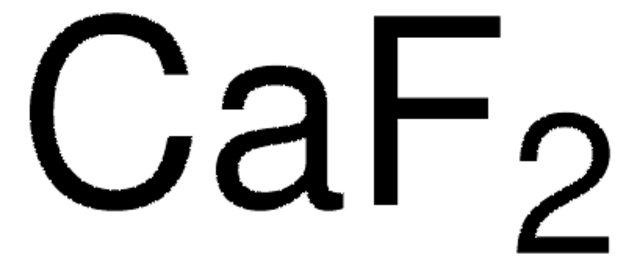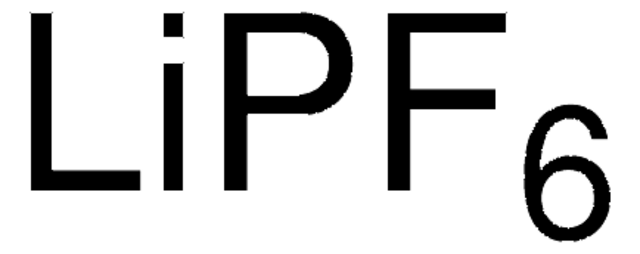1.05686
Lithium fluoride
for inorganic trace analysis, 99.99 Suprapur®
Synonyme(s) :
Lithium fluoride
About This Item
Produits recommandés
Qualité
for inorganic trace analysis
Niveau de qualité
Essai
99.99%
Forme
solid
Puissance
143 mg/kg LD50, oral (Rat)
pb
1676 °C/1013 hPa
Pf
870 °C
Densité
2.64 g/cm3 at 20 °C
Masse volumique apparente
600 kg/m3
Température de stockage
2-30°C
Chaîne SMILES
[Li+].[F-]
InChI
1S/FH.Li/h1H;/q;+1/p-1
Clé InChI
PQXKHYXIUOZZFA-UHFFFAOYSA-M
Catégories apparentées
Application
- Radical Polymer-based Positive Electrodes for Dual-Ion Batteries: Describes the enhancement of battery performance through the use of γ-Butyrolactone-based electrolytes in conjunction with radical polymer-based positive electrodes, highlighting advances in lithium carbonate applications in battery technology (Rudolf K, et al., 2024).
- Analysis of Trace Impurities in Lithium Carbonate: Focuses on the precision analysis of impurities within pharmaceutical grade lithium carbonate, crucial for maintaining high purity standards in pharmaceutical applications (Suárez A, et al., 2024).
- Effects of Central Metal Ion on Binuclear Metal Phthalocyanine-Based Redox Mediator for Lithium Carbonate Decomposition: Investigates the role of central metal ions in enhancing the efficiency of lithium carbonate decomposition, important for environmental lithium analysis and recovery (Yan Q, et al., 2024).
- Selective preparation of lithium carbonate from overhaul slag by high temperature sulfuric acid roasting - Water leaching: Details a method for extracting high-purity lithium carbonate from industrial waste, demonstrating an environmentally friendly approach to lithium recovery (Dong L, et al., 2024).
- Reactive molecular dynamics simulations of lithium-ion battery electrolyte degradation: Explores the degradation mechanisms of lithium-ion battery electrolytes using simulations, contributing to the development of more durable lithium battery materials (Mabrouk Y, et al., 2024).
Remarque sur l'analyse
Ba (Barium): ≤ 5.0 ppm
Ca (Calcium): ≤ 2.0 ppm
Cd (Cadmium): ≤ 0.5 ppm
Co (Cobalt): ≤ 0.5 ppm
Cs (Cesium): ≤ 20 ppm
Cu (Copper): ≤ 0.5 ppm
Fe (Iron): ≤ 0.5 ppm
K (Potassium): ≤ 10 ppm
Mg (Magnesium): ≤ 0.5 ppm
Mn (Manganese): ≤ 0.5 ppm
Na (Sodium): ≤ 10 ppm
Ni (Nickel): ≤ 0.5 ppm
Pb (Lead): ≤ 0.5 ppm
Rb (Rubidium): ≤ 10 ppm
Sr (Strontium): ≤ 5 ppm
Zn (Zinc): ≤ 0.5 ppm
Informations légales
Mention d'avertissement
Danger
Mentions de danger
Conseils de prudence
Classification des risques
Acute Tox. 3 Oral - Eye Irrit. 2 - Skin Irrit. 2 - STOT SE 3
Organes cibles
Respiratory system
Risques supp
Code de la classe de stockage
6.1C - Combustible, acute toxic Cat.3 / toxic compounds or compounds which causing chronic effects
Classe de danger pour l'eau (WGK)
WGK 2
Point d'éclair (°F)
Not applicable
Point d'éclair (°C)
Not applicable
Certificats d'analyse (COA)
Recherchez un Certificats d'analyse (COA) en saisissant le numéro de lot du produit. Les numéros de lot figurent sur l'étiquette du produit après les mots "Lot" ou "Batch".
Déjà en possession de ce produit ?
Retrouvez la documentation relative aux produits que vous avez récemment achetés dans la Bibliothèque de documents.
Les clients ont également consulté
Notre équipe de scientifiques dispose d'une expérience dans tous les secteurs de la recherche, notamment en sciences de la vie, science des matériaux, synthèse chimique, chromatographie, analyse et dans de nombreux autres domaines..
Contacter notre Service technique






